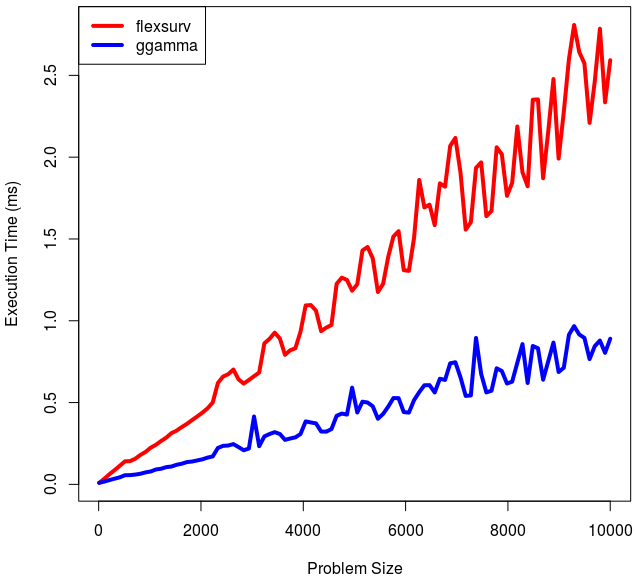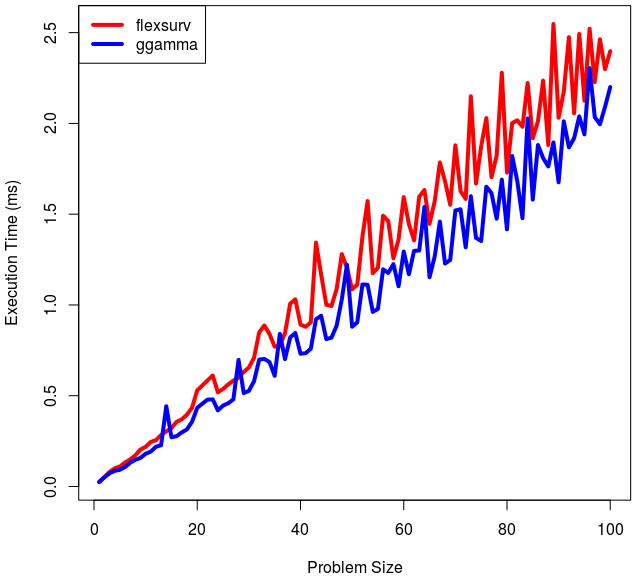Here we give details regarding the ggamma package that we developed (package here).
Our main objective is to provide an efficient implementation of the generalized gamma in its original parametrization,
which is currently provided solely by the flexsurv package under the name of dgengamma.orig,
but as we will argue later it does not have very good performance.
What we mainly do here is compare our implementation of the generalized gamma distribution with the one offered
by the flexsurv package.
Note that the source code can be found in the GitHub repository.
Formulas
Our implementation was mainly motivated by the slow performance of existing implementations. Let us first elaborate on the formulas for the distribution, and then discuss its implementation and performance.
The generalized gamma was proposed by Stacy, E. W. [1] with parameters $a, d, p$, but we use the reparametrization
$$
a = a
$$
$$
b = p
$$
$$
k = \frac{d}{p}
$$
similar to how flexsurv does (they offer two parametrizations, this is one of them).
The distribution function is $$ f(x) = \frac{b x^{bk-1} \exp[-(x/a)^b]}{a^{bk} \Gamma(k)} $$ and the cumulative distribution function is $$ F(x) = \frac{\gamma(k, (x/a)^p)}{\Gamma(k)} $$ where $\gamma(s, x) = \int_0^x t^{s-1} e^{-t} dt$ is the lower incomplete gamma function.
In order to find the quantile function, we would need to invert such $F(x)$, which is not a trivial task due to the use of the gamma function. However, recall that the cumulative distribution function for a $Gamma(\alpha, \beta)$ with $\alpha = k$ and $\beta = 1$ is $$ G(x) = \frac{\gamma(k, x)}{\Gamma(k)} $$ so $F(x)$ can be rewritten as $$ F(x) = G((x/a)^p) $$
We thus run into a case of a $G(h(x)) = G \circ h$ whose inverse is $h^{-1} \circ G^{-1}$, which would give the quantile function for $F$ in terms of the quantile function for the Gamma distribution $G^{-1}$. The relation is as follows $$ F^{-1}(y) = a \cdot (G^{-1}(y))^\frac{1}{p} $$ which is how we compute the quantile function for the generalized gamma.
Implementation Considerations
Our previous experience with implementing the elfDistr package showed that using C++ not necessarily leads to better performance.
To test this, we use the following code (we actually tested more scenarios, but these two will suffice here):
require(Rcpp)
require(microbenchmark)
dggamma1 = function(x, a, b, k, log=F){
result = log(b) - lgamma(k) + (b*k - 1)*log(x) - (b*k)*log(a) - (x/a)**b;
if(!log) result = exp(result);
return(result);
}
cppFunction("
NumericVector dggamma4(
NumericVector &vx,
NumericVector &va,
NumericVector &vb,
NumericVector &vk,
const bool &log_prob = false
){
int maxLength = std::max({
vx.length(),
va.length(),
vb.length(),
vk.length()
});
NumericVector p(maxLength);
for(int i = 0; i < maxLength; i++){
const double x = vx[i % vx.length()];
const double a = va[i % va.length()];
const double b = vb[i % vb.length()];
const double k = vk[i % vk.length()];
p[i] = std::log(b) - R::lgammafn(k) + (b*k - 1)*std::log(x) - (b*k)*std::log(a) - std::pow(x/a, b);
}
if(!log_prob)
p = Rcpp::exp(p);
return p;
}
");
x = seq(0, 10, length=10000);
result = microbenchmark(
dggamma1(x, 1, 1, 1),
dggamma4(x, 1, 1, 1),
unit="ms",
times=1000,
control=list(warmup=100)
)
print(summary(result))This code yields the following output
> source("test.r")
expr min lq mean median uq max neval
1 dggamma1(x, 1, 1, 1) 0.482550 0.500241 0.6422052 0.6042855 0.615583 8.177283 1000
2 dggamma4(x, 1, 1, 1) 1.795065 1.841203 2.1034001 2.2448835 2.268327 3.468884 1000so as can be seen under the mean column, the R implementation happens to be faster in this case. Of course, we could tinker the C++ code to use parallel processing, or try to modify code to make better use of cache memories or allow the compiler to vectorize the code more easily. This would actually lead to a very cryptic code with terrible maintainability, and it likely would not reach the 0.6 seconds of the R implementation.
The flexsurv package implements the generalized gamma using C++. They do not do any of these code optimizations; far from that, they made aggressive use of object orientation, encapsulating and modularizing things to make the code more maintainable. This is great, code maintainability is extremely important for such a big package. However, encapsulation and modularization unfortunately lead to less efficient code. Consider the following benchmark now:
require(flexsurv)
require(elfDistr)
require(microbenchmark)
flexsurv.test = function(){
x = runif(0, 10, n=10000);
return( sum(dgengamma(x, 1, 1, 1, log=T)) );
}
flexsurv.test.orig = function(){
x = runif(0, 10, n=10000);
return( sum(dgengamma.orig(x, 1, 1, 1, log=T)) );
}
elf.test = function(){
x = runif(0, 10, n=10000);
return( sum(dggamma(x, 1, 1, 1, log=T)) );
}
result = microbenchmark(
flexsurv.test(),
flexsurv.test.orig(),
elf.test(),
unit="ms",
times=1000,
control=list(warmup=100)
)
print(summary(result))where we are comparing the performance of three distribution functions: 1) flexsurv's generalized gamma in its main parametrization; 2) flexsurv's generalized gamma in the same parametrization we used; and 3) our implementation dggamma. The output of this code in my machine is:
> source("test.r")
expr min lq mean median uq max neval
1 flexsurv.test() 2.086867 2.150671 2.4591341 2.6028125 2.6573650 4.430079 1000
2 flexsurv.test.orig() 2.538304 3.172489 5.0088479 3.5958015 4.2179430 87.284218 1000
3 elf.test() 0.676841 0.697649 0.8304953 0.7983525 0.8657395 2.728748 1000so again under the mean column we see that our implementation ends up being faster than theirs.
Finally, the figures below show the same comparison above, but varying the problem size. Here we call dgengamma(x, a, b, k) and dggamma(x, a, b, k) with varying sizes for the vector x, and a, b, k are single elements. In the second image, we only change a, b, k to be vectors with sizes respectively 13, 64, 37 to test how well these functions work with recycling. In both cases we see that ggamma wins, and is much faster in the first case where a, b, k are single values. When recycling is imposed, both packages have similar execution times.


References
[1] - Stacy, E. W. (1962). A generalization of the gamma distribution. The Annals of mathematical statistics, 33(3), 1187-1192.